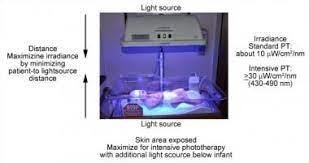A nurse is contributing to the plan of care for a newborn who requires phototherapy for hyperbilirubinemia. Which of the following interventions should the nurse recommend including in the plan?
Apply a water-based ointment to the newborn's skin every 4 to 6 hr.
Give the newborn 30 mL of distilled water after each feeding
Reposition the newborn every 2 to 3 hr.
Monitor the newborn's blood glucose level every 2 hr
The Correct Answer is C
A) Incorrect- Applying ointment to the skin during phototherapy is typically avoided as it can interfere with the effectiveness of the therapy.
B) Incorrect- Giving distilled water after feedings is not a typical intervention for phototherapy.
C) Correct - Repositioning the newborn every 2 to 3 hours is important to ensure adequate exposure of the skin to the phototherapy lights and to prevent pressure points.
D) Incorrect- Monitoring blood glucose levels is not a standard intervention during phototherapy unless there are specific indications for doing so.

Nursing Test Bank
Naxlex Comprehensive Predictor Exams
Related Questions
Correct Answer is D
Explanation
A) Incorrect- Overlapping suture lines in a newborn are common and usually resolve as the baby grows. This finding is not typically concerning.
B) Incorrect- Acrocyanosis, bluish discoloration of the hands and feet, is common in newborns and is a normal physiological response to adjusting to the outside environment.
C) Incorrect- Hypotonia, or decreased muscle tone, can be present in newborns and may improve over time. It's important to monitor but may not necessarily require immediate reporting.
D) Correct - A blood glucose level of 40 mg/dL in a newborn is considered low and requires intervention. Hypoglycemia in a newborn can have serious consequences and should be promptly addressed.
Correct Answer is C
Explanation
A) Incorrect- Elevated blood pressure is not a primary risk associated with hyperemesis gravidarum.
B) Incorrect- Leukopenia (low white blood cell count) is not a common consequence of hyperemesis gravidarum.
C) Correct - Hyperemesis gravidarum, severe nausea, and vomiting during pregnancy can lead to dehydration, which may affect amniotic fluid levels and result in hydramnios (excessive amniotic fluid).
D) Incorrect- Ketonuria (presence of ketones in the urine) is a possible consequence of excessive vomiting, but it's not the primary concern associated with hyperemesis gravidarum.
Whether you are a student looking to ace your exams or a practicing nurse seeking to enhance your expertise , our nursing education contents will empower you with the confidence and competence to make a difference in the lives of patients and become a respected leader in the healthcare field.
Visit Naxlex, invest in your future and unlock endless possibilities with our unparalleled nursing education contents today
Report Wrong Answer on the Current Question
Do you disagree with the answer? If yes, what is your expected answer? Explain.
Kindly be descriptive with the issue you are facing.
